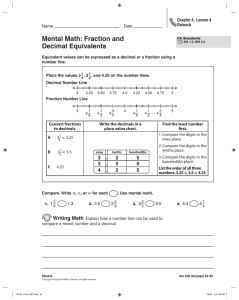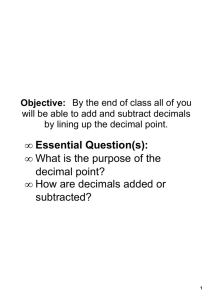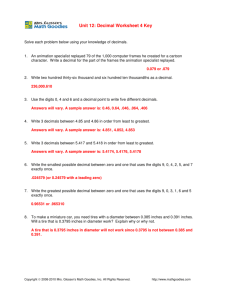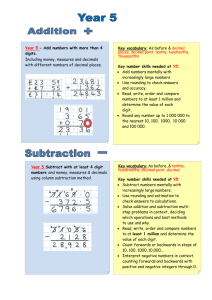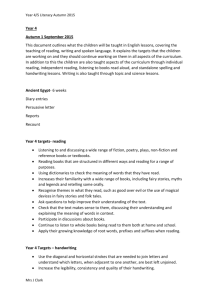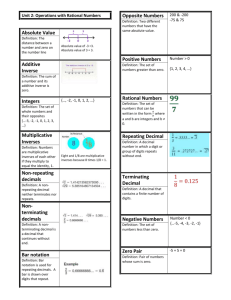Microsoft Word - 2015 Year 4 Expectations
advertisement
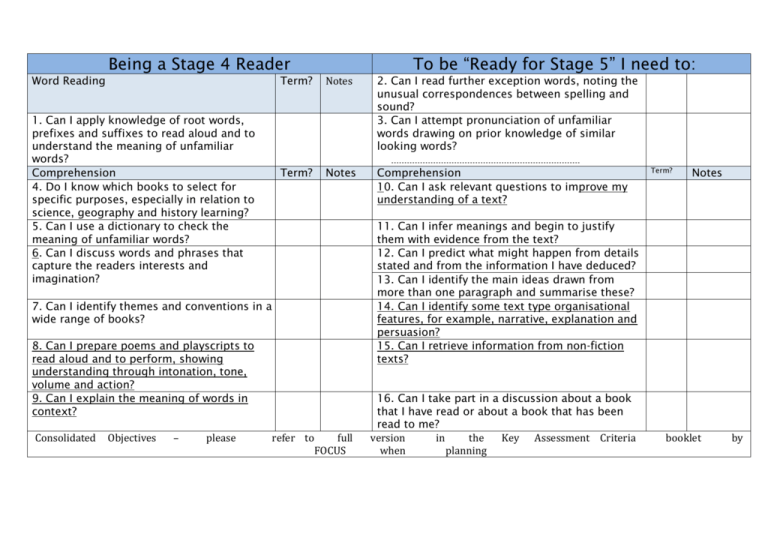
Being a Stage 4 Reader Word Reading 1. Can I apply knowledge of root words, prefixes and suffixes to read aloud and to understand the meaning of unfamiliar words? Comprehension 4. Do I know which books to select for specific purposes, especially in relation to science, geography and history learning? 5. Can I use a dictionary to check the meaning of unfamiliar words? 6. Can I discuss words and phrases that capture the readers interests and imagination? To be “Ready for Stage 5” I need to: Term? Notes 2. Can I read further exception words, noting the unusual correspondences between spelling and sound? 3. Can I attempt pronunciation of unfamiliar words drawing on prior knowledge of similar looking words? Term? Notes Comprehension 10. Can I ask relevant questions to improve my understanding of a text? 8. Can I prepare poems and playscripts to read aloud and to perform, showing understanding through intonation, tone, volume and action? 9. Can I explain the meaning of words in context? Objectives – please Notes 11. Can I infer meanings and begin to justify them with evidence from the text? 12. Can I predict what might happen from details stated and from the information I have deduced? 13. Can I identify the main ideas drawn from more than one paragraph and summarise these? 14. Can I identify some text type organisational features, for example, narrative, explanation and persuasion? 15. Can I retrieve information from non-fiction texts? 7. Can I identify themes and conventions in a wide range of books? Consolidated Term? refer to full FOCUS 16. Can I take part in a discussion about a book that I have read or about a book that has been read to me? version in the Key Assessment Criteria when planning booklet by Being a Stage 4 Writer Consolidated Objectives Criteria To Be “Ready for Stage 5” I need to: – please refer booklet by Spelling Term? to full version FOCUS when planning Notes 1. Can I spell the commonly mis-spelt words from the Y3/4 list? 2. Can I recognise and spell homophones? 3. Can I use the first two or three letters of a word to check a spelling in a dictionary? Composition 6. Can I compose sentences using a range of sentence structures? 7. Can I orally rehearse a sentence or a sequence of sentences? 8. Can I write a narrative with a clear structure setting and plot? 9. Can I improve my writing by changing grammar and vocabulary to improve consistency? Term? Notes in the Key Assessment Transcription Handwriting 4. Do I understand which letters should be left unjoined? 5. Is my handwriting legible and consistent; lines of writing are spaced sufficiently so that ascenders and descenders of letters do not touch? Composition Term? Notes Term? Notes 10. Can I use a range of sentences which have more than one clause? 11. Can I use appropriate nouns and pronouns within and across sentence to support cohesion and avoid repetition? 12. Can I use direct speech in my writing and punctuate it correctly? Grammar and Punctuation (SPAG seen in context) Term? Sentence Structure Notes Punctuation 13. Can I use noun phrases which are expanded 16. Can I use apostrophes to mark plural by adding modifying adjectives, nouns and possession? preposition phrases? 14. Can I use fronted adverbials? 17. Can I use commas after fronted Term? adverbials? Text Structure Notes Term? Notes 15. Can I organise paragraphs around a theme? Year 1 Year 2 Can I sit correctly at a table, holding a pencil comfortably and correctly? Can I form lower case letters in the correct direction, starting and finishing in the right place? Can I form capital letters and digits 0-9? Handwriting – (Separately Graded, Not Included in %) Year 3 Year 4 Can I join my writing and show that I know which letters are best left unjoined? Can I form lower-case letters of the correct size relative to one another and use capital letters and digits of the correct size and relationship to one another and to lower case letters ? Can I use spacing between words that reflects the size of the letters? Can I use the diagonal and horizontal strokes that are needed to join letters? Do I understand which letters should be left unjoined? Being a Stage 4 Mathematician Consolidated Objectives Criteria booklet by Number – please refer to FOCUS when planning Term? Notes Year 6 Can I write legibly and fluently, developing speed and an appropriate personal style? full version in the Key Assessment Number Term? Notes Term? Notes 6. Can I add and subtract with up to 4 digits using formal written methods of columnar addition and subtraction? And use inverse to check? 7. Can I divide a 1 or 2-digit number by 10 or 100 identifying the value of the digits in the answer as units, tenths and hundredths? 8. Can I multiply 2-digit and 3-digit numbers by a 1digit number using formal written layout? 9. Can I solve two-step addition and subtraction problems in context? 10. Can I solve problems involving multiplication and division? 2. Can I count in multiples of 25 and 1000? 3. Can I count backwards through zero to include negative numbers? 4. Can I compare numbers with the same number of decimal places up to 2-decimal places? 5. Can I read roman numerals to 100? 11. Can I compare and classify geometrical shapes, including quadrilaterals and triangles, based on their properties and sizes? 12. Do I know that angles are measured in degrees and can identify acute and obtuse angles? 13. Can I compare and order angles up to two right angles by size? 14. Can I solve comparison, sum and difference problems using information presented in bar charts, pictograms, tables and other graphs? Can I write legibly and fluently, developing speed and an appropriate personal style? To Be ready for “Stage 5” I need to: 1. Can I recall all multiplication facts to 12 x 12 and factor pairs? Measurement and Geometry Year 5 Can I use the diagonal and horizontal strokes that are needed to join letters? Do I understand which letters should be left unjoined? Is my handwriting legible and consistent; down strokes of letters are parallel and equidistant; lines of writing are spaced sufficiently so that ascenders and descenders of letters do not touch? Term? Notes Measurement and Geometry 15. Can I measure and calculate the perimeter of a rectilinear figure in cm and m and find an area by counting squares? 16. Can I read, write and convert between analogues and digital 12 and 24-hour times? 17. Can I convert between different units of measurement e.g. km to m, hour to minute? 18. Can I interpret and present discrete and continuous data using appropriate graphical methods, including bar charts and time graphs? Fraction and decimals 19. Can I recognise and write decimal equivalents of any number of tenths or hundredths as well as ¼, ½ and ¾? 20. Can I recognise and show using diagrams, families of common equivalent fractions e.g. ¼ = 2/8? 21. Can I solve problems to calculate quantities e.g. ¾ of 36? Term? Notes Fraction and decimals 22. Can I round any number to the nearest 10, 100 or 1000 and decimals with one decimal place to the nearest whole number? 23. Can I add and subtract fractions with the same denominator? 24. Can I solve simple measures and money problems involving fractions and decimals to two decimal places? Term? Notes

